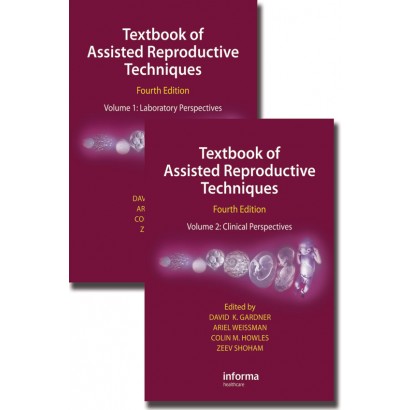|
|
|
| |
 |
|
|

|
 推薦指數:
推薦指數:





|
|
- 內容介紹
|
Textbook of Assisted Reproductive Techniques, Two Volume Set, Fourth Edition
Availability: In stock
ISBN: 9781841849744
David K Gardner, Ariel Weissman, Colin M Howles, Zeev Shoham
Textbook of Assisted Reproductive Technologies has become a classic comprehsive reference for the whole team at the IVF clinic. The fourth edition comes more conveniently as a set of two separate volumes, one for laboratory aspects and the other for clinical applications.
The text has been extensively revised, with the addition of several important new contributions on laboratory aspects including developing techniques such as PICSI, IMSI, and time-lapse imaging. The second volume focuses on clinical applications and includes new chapters on lifestyle factors, tailored ovarianstimulation, frozen-thawed embryo transfer, viral disease, and religious perspectives. As before, methods, protocols, and techniques of choice are presented by eminent international experts.
Contents:
Establishing and Maintaining an IVF Laboratory
Setting up an ART laboratory
Quality control: maintaining stability in the laboratory
The ART laboratory: current standards
II Gamete Collection, Preparation and Selection
Evaluation of sperm
Sperm preparation techniques
Sperm chromatin assessment
Oocyte retrieval and selection
Preparation and evaluation of oocytes for ICSI
Hyaluronic acid binding-mediated sperm selection for ICSI
Intracytoplasmic morphologically-selected sperm injection
Use of In Vitro Maturation in a clinical setting: patient populations and outcomes
III Micromanipulation
Equipment and general technical aspects of micromanipulation of gametes and embryos
Intracytoplasmic sperm injection: technical aspects
Assisted hatching
Human embryo biopsy procedures
IV Culture, Selection and Transfer of the Human Embryo
Analysis of fertilization
Culture systems for the human embryo
Evaluation of embryo quality: analysis of morphology and quantification of nutrient utilization and the metabolome
Evaluation of embryo quality: time lapse imaging to assess embryo morphokinesis
Evaluation of embryo quality: Proteomic strategies
V Cryopreservation
The human oocyte: controlled rate cooling
The human oocyte: vitrification
The human embryo: slow freezing
The human embryo: vitrification
VI Diagnosis of Genetic Disease in Preimplantation Embryos
Severe male factor: genetic consequences and recommendations for genetic testing
Polar body biopsy and its clinical application
Preimplantation genetic diagnosis for infertility
Genetic analysis of the embryo
VII Implantation
The analysis of endometrial receptivity
VIII Quality Management Systems
Quality management in reproductive medicine
IX Patient Investigation and the Use of Drugs
Lifestyle, periconception, and fertility
Indications for IVF treatment: from diagnosis to prognosis
Initial investigation of the infertile couple
Prognostic testing for ovarian reserve
Drugs used for ovarian stimulation: clomiphene citrate, aromatase inhibitors, metformin, gonadotropins, gonadotropin-releasing hormone analogs, and recombinant gonadotropins
The role of FSH and LH in ovulation induction: current concepts
X Stimulation Protocols
Endocrine characteristics of ART cycles
The use of GnRH agonists
GnRH antagonists in ovarian stimulation for IVF
The use of AMG to tailor ovarian stimulation for IVF
Monitoring ovarian response in IVF cycles
Oocyte collection
Luteal support in ART
Treatment strategies in assisted reproduction for the low responder patient
Repeated implantation failure: the preferred therapeutic approach
XI Technical Procedures and Outcomes
Ultrasonography in Assisted Reproduction
Sperm-recovery techniques: clinical aspects
Processing and cryopreservation of testicular sperm
Embryo transfer technique
Cycle regimens for frozen-thawed embryo transfer
Anesthesia and in vitro fertilization
Medical considerations of single embryo transfer (SET)
XII Special Medical Conditions
Endometriosis and ART
PCOS and assisted reproduction
Management of hydrosalpinx
Fertility preservation strategies
Viral disease and ART
XIII Complications of Treatment
Severe ovarian hyperstimulation syndrome
The environment and reproduction
Bleeding, severe pelvic infection, and ectopic pregnancy
Iatrogenic multiple pregnancy: the risk of ART
XIV Egg Donation and Surrogate Motherhood
Egg and embryo donation
Gestational surrogacy
XV Future Directions and Clinical Applications
Human embryonic stem cells
Microfluidics in ART: current progress and future directions
XVI The Support Team
The evolving role of the ART nurse: a contemporary review
Patient support in the ART program
The relationship between stress and in vitro fertilization outcome
XV Future Directions and Clinical Applications
Human embryonic stem cells
XVII Ethics, Religion and Legislation
The impact of legislation and socioeconomic factors in the access to and global practice of assisted reproduction
Religious perspectives in human reproduction
|
|
|

